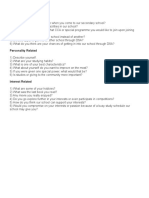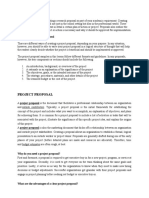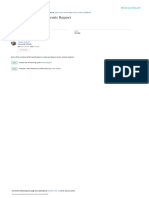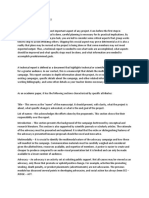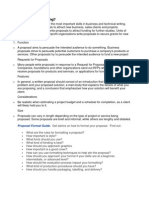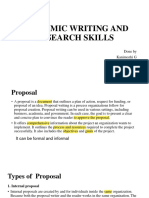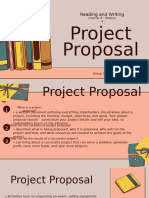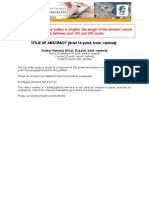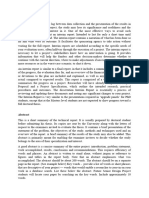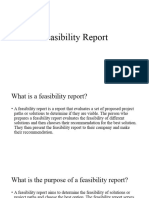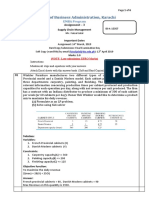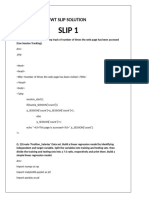Final Report Guidelines July 2012
Final Report Guidelines July 2012
Uploaded by
mgunsungCopyright:
Available Formats
Final Report Guidelines July 2012
Final Report Guidelines July 2012
Uploaded by
mgunsungCopyright
Available Formats
Share this document
Did you find this document useful?
Is this content inappropriate?
Copyright:
Available Formats
Final Report Guidelines July 2012
Final Report Guidelines July 2012
Uploaded by
mgunsungCopyright:
Available Formats
Guidelines for writing a final project report July 2012
FoNS has a strong commitment to disseminating the work of the project teams that we support. Developing and changing practice to improve patient care is complex and we therefore believe it is essential to share the outcomes, learning and experiences of those involved in such work. This contributes to the growing knowledge base about effective ways of leading and facilitating positive patient outcomes and sustainable changes in practice. An effective means of achieving this is the production of a final report. All completed projects have an individual web page on the FoNS website from which copies of the final reports can be downloaded. Visit www.fons.org/library/projectreports.aspx for examples. Submission process FoNS acknowledges that some project leaders/teams may have limited experience of writing project reports or be unused to writing about the processes and outcomes of developing practice. The FoNS Practice Development Facilitators are therefore happy to offer guidance and support in the report writing process as appropriate e.g. help with developing a report outline; providing feedback and critique on draft reports etc. This help will start during the project following the submission of interim reports, and therefore project leaders should expect to dedicate/allocate some specific and continued time for the writing process as part of their project. Once a draft final report has been submitted to FoNS, it will be reviewed. At this point, as with the submission of articles to journals, it is highly likely that some revisions, additions etc. will be suggested. These will be based upon the desire to produce reports that provide reliable and credible information upon which future development work can be based. We are aiming to achieve a standard that would be accepted for journal publication. Who is the reader? Project reports are accessed by nurses and healthcare practitioners from all over the UK and beyond via the FoNS website. You should therefore assume that the reader is someone who does not know anything about your project but who may be interested in replicating your work in their own healthcare setting. Your report should therefore include all the details about the what?, why? and how? that would enable someone to do this. Writing in the third person We would strongly advise that reports are written in the third person. This provides a greater sense of objectivity and distance as the focus is on what is being said rather than who is saying it. To write in the third person you write as if you are an outsider reporting on the aims, methods and outcomes of your project, rather than writing as though they are happening to you. First person
FoNS guidelines for writing a final project report July 2012
pronouns such as "I" and "We" are replaced with third person pronouns such as "the project leader/team", "he/she, "it" and "they". Your report may however also include some reflections and it is of course appropriate if these sections are written in the first person. FoNS Dissemination Series: Improvement Insights In most cases, final reports will be edited by FoNS to create a one page summary which will be published as part of the FoNS Dissemination Series: Improvement Insights. This editing is undertaken by FoNS to ensure that the summaries fit with the house style of this series; however, the summary will be sent to project leaders for approval before publication. This summary will include the web site address of the web page where your full final report can be accessed. This series has an ISSN number and is therefore searchable on most databases. It is also sent to all nursing and healthcare libraries UK wide and is available to download, free of charge from the FoNS website (see http://www.fons.org/library/dissemination-series.aspx, volumes 6 onwards). Project Report Template A report template is provided on the following pages which includes suggested headings and brief content guidance. Further support can be provided by the FoNS Practice Development Facilitators.
FoNS guidelines for writing a final project report July 2012
Project Report Template
Project Title Keywords: Identify approximately 5 key words/phrases that will be used to facilitate searching Duration of project: Month Year Month Year Date report submitted for publication: Month Year Project leader or team: Name(s) and job title (s) Contact details: Email address of main contact Summary of project Approximately 200 words. We strongly recommend that you write this when the report is finished. It should briefly outline what you did, why you did it, key outcomes and recommendations. Background or Introduction This section should briefly outline the reason for doing the project and provide an overview of key supporting evidence i.e. identification of local need, research evidence, policy drivers etc. Relevant contextual information can also be included e.g. information about patients/service users, staff, healthcare setting etc. Body of report The headings included in the body of the report will vary for each project. However, it is likely that these will include: the aims and objectives of the project the methods and approaches that were used to meet the aims the outcomes of the project discussion Aim(s) (and objectives) of the project Clearly identify the aim(s) (and objectives if you have them) of the project Aim what you are trying to achieve Objectives how you will achieve the aim Your outcomes and discussion sections should refer back to the aims and objectives to identify if the aims have been met and if the objectives were effective in enabling you to meet these.
FoNS guidelines for writing a final project report July 2012
Methods and approaches Brief overview It is helpful, if possible to start this section with a few sentences to briefly overview the approaches that you used. For example: A number of approaches were used to facilitate the changes in practice. These included: Observation of practice Patient interviews Staff focus groups You can then use these bullet points as sub-headings in the report What?, why? and how? This section should include the what?, why? and how? of your project to enable others to learn from your experience and build on your work. So for example, if your project involved patient interviews (the what?), include a brief explanation about why you decided to use this approach; then provide clear details about how the interviews were undertaken. This should include details about: The interview schedule how it was developed and by who How patients were selected Who conducted the interviews Ethical issues e.g. informed consent, data collection and storage, confidentiality, use of data How many interviews were conducted How data was recorded How the data was analysed and used to inform the project Similarly, if your project involved staff questionnaires (what?), include a brief explanation about why you decided to use this approach; then provide clear details about how the questionnaires were distributed, collected and analysed. This should include details about: How the questionnaire was selected or developed How the questionnaire was distributed and returned including how many and to who Ethical issues e.g. data collection and storage, anonymity/confidentiality, use of data How the data was analysed and used to inform the project You may have facilitated workshops for staff; again the report should identify the purpose of the workshops (what?); why you decided that this was an appropriate approach for your project; and how they were facilitated including: How the workshop programme was developed How staff were invited and/or selected to attend and how many attended An overview of the content Evaluation feedback from participants including how this was collected Outcomes/Findings/Evaluation This section should report on the outcomes or findings from the project. Ideally, this information should enable the reader to determine if the aims of the project have been achieved.
FoNS guidelines for writing a final project report July 2012
The outcomes of your project should be identified and then illustrated with supportive evidence. This evidence should be tangible rather than purely anecdotal or opinion based e.g. care has improved, patients are more satisfied. For example, a questionnaire was used to evaluate the impact of a staff workshop on dignity in care in a number of ways: Quantitative evidence - 92% of respondents reported that the care they gave had changed Qualitative evidence When a patient is upset, angry and aggressive, I now try and see it from their point of view For example, mealtime practice was observed and the following changes in practice (as compared with practice before the project commenced) were noted: Drug round no longer takes place at the same time as meals All nurses are involved in mealtimes Meal presentation given high priority Handovers observed to be more patient centred that task focused Discussion Some discussion, critique, reflection on your project should be included in your report. A separate section could be created for this or it could be incorporated into the relevant sections of the report. Readers will be interested to learn from the experiences of the project teams and therefore the following questions may be useful to consider: Was the project successful in meeting its aims? What went well and why? What didnt go well and why? What would you do differently and why? Conclusion A summary of the previous major headings (with no new material added) and conclusions drawn or recommendations for the future. Recommendations Some projects will have identified a number of recommendations and these should be included here. References All references should be provided in full. In the text, the following format should be used: there is no evidence to suggest that the standard of care has improved (Breslin, 2009). Shaw (2009) argues that much of the success of practice development Reason and Bradbury (2001, p1) suggest that action research: seeks to bring N.B. page numbers for direct quotes must be included.
FoNS guidelines for writing a final project report July 2012
In the reference list, the following format should be used: Atree, M. (2001) Patients and relatives experiences of "good and not so good" quality care. Journal of Advanced Nursing. Vol. 33. No. 4. pp 456-466. Lipley, N. (2006) Government plans dignity nurses for older patients. Retrieved from: www.nursing-standard.co.uk/nursingmanagement/news2.asp. (Last accessed 1st September 2009). Manley, K. (2004) Transformational culture: a culture of effectiveness. Chp 4 in McCormack, B., Manley, K. and Garbett, R. (Eds) (2004) Practice Development in Nursing. Oxford: Blackwell Publishing. Scott, T., Mannion, R., Davies, H. and Marshall, M. (2003) Healthcare Performance and Organisational Culture. Oxford: Radcliffe Medical Press Ltd. Acknowledgements Acknowledgements can be included. These are an opportunity to thank people that have been involved, helped and supported your work. There is not sufficient space in the FoNS Dissemination Series: Improvement Insights to include acknowledgements.
FoNS guidelines for writing a final project report July 2012
You might also like
- Dissertation Progress Report SampleDocument8 pagesDissertation Progress Report SampleWhoWillWriteMyPaperForMeSaintPaul100% (1)
- Masters Research Proposal TemplateDocument8 pagesMasters Research Proposal TemplateAiman Maran67% (3)
- DSA Interview QuestionsDocument1 pageDSA Interview QuestionsPennNo ratings yet
- Biology Workbook Answers - Google SearchDocument1 pageBiology Workbook Answers - Google SearchNoha ShaabanNo ratings yet
- Report WritingDocument21 pagesReport WritingDivya Singhal100% (3)
- Project ProposalDocument5 pagesProject Proposalhoney moreno100% (2)
- Dungeon Bounty OCT UpdateDocument16 pagesDungeon Bounty OCT Updatedesmontes100% (2)
- Final Report Guidelines July 2012Document6 pagesFinal Report Guidelines July 2012Sentinel BergNo ratings yet
- Unit 7 - Proposal and Report WritingDocument16 pagesUnit 7 - Proposal and Report WritingFransiska Way Warti RobertsonNo ratings yet
- How To Write An Academic ReportDocument37 pagesHow To Write An Academic ReportbrendaNo ratings yet
- 1 Report WritingDocument32 pages1 Report WritingAyesha Tahir100% (1)
- Lecture 1& 2 IntroductionDocument28 pagesLecture 1& 2 IntroductionMuhammad UmairNo ratings yet
- Week 6 SeminarDocument27 pagesWeek 6 SeminarTendai MatomaNo ratings yet
- MG 312 Project Final GuidelineDocument5 pagesMG 312 Project Final Guidelinelycanderek08No ratings yet
- Joint Field Project W 05Document5 pagesJoint Field Project W 05Jazib Ali ShahNo ratings yet
- Writing A Marketing Research ReportDocument9 pagesWriting A Marketing Research Reportaprille altNo ratings yet
- C25: Communicating Research Results: Report Generation, Oral Presentation, and Follow-UpDocument5 pagesC25: Communicating Research Results: Report Generation, Oral Presentation, and Follow-UpUhhu NormanNo ratings yet
- What Reports AreDocument27 pagesWhat Reports AreMohd HafiqNo ratings yet
- Progress Report Research PaperDocument4 pagesProgress Report Research Paperzyfepyfej0p2100% (1)
- Report Writing: by Aimen, Ayesha, Rida & HalimaDocument27 pagesReport Writing: by Aimen, Ayesha, Rida & HalimaBushra SyedNo ratings yet
- Report WritingDocument10 pagesReport WritingLiza Ermita AmzarNo ratings yet
- Evaluation Report TemplateDocument6 pagesEvaluation Report Templatenifras1234No ratings yet
- 7 How To Write A Report and Presentation v3Document7 pages7 How To Write A Report and Presentation v3Jeremiah HiiNo ratings yet
- RW Research Report Project Proposal Position PaperDocument39 pagesRW Research Report Project Proposal Position PaperzizizildieNo ratings yet
- How To Write An Academic ReportDocument37 pagesHow To Write An Academic Reportmukiibirhines2001100% (1)
- Report TemplateDocument4 pagesReport TemplateBeyourself9999No ratings yet
- How To Write An Academic ReportDocument37 pagesHow To Write An Academic ReportYulyana AnjaniNo ratings yet
- Reports Business 2023Document6 pagesReports Business 2023jeramieolinNo ratings yet
- Logic Model Workplan - Endowment For HealthDocument10 pagesLogic Model Workplan - Endowment For Healthexplo4747No ratings yet
- WWWWWDocument3 pagesWWWWWSharon ChenNo ratings yet
- Writing Project ProposalDocument30 pagesWriting Project ProposalJaze Marco100% (1)
- Proposal WritingDocument23 pagesProposal Writingsamarthbhatia100% (1)
- Project GuidelinesDocument18 pagesProject GuidelinesKaustav MannaNo ratings yet
- Research Methodology 115614Document10 pagesResearch Methodology 115614Suraj DasguptaNo ratings yet
- MC New ReportDocument51 pagesMC New Reportk07011994No ratings yet
- Research Proposal SeminarDocument30 pagesResearch Proposal SeminarAfrin FarookNo ratings yet
- Project Report and Synopsis Format, TemplateDocument5 pagesProject Report and Synopsis Format, Templatecromwel rosalesNo ratings yet
- Chapter 2 Technical Writing Reading AssignmentDocument8 pagesChapter 2 Technical Writing Reading AssignmentAlykah Dela CruzNo ratings yet
- Week-3 (1)Document20 pagesWeek-3 (1)tasimuddinsohanNo ratings yet
- English Iv MidtermDocument5 pagesEnglish Iv MidtermTania AliNo ratings yet
- Proposal Tips & Hints: Section I: P ODocument9 pagesProposal Tips & Hints: Section I: P OBruce BarrosNo ratings yet
- What Is A Project ProposalDocument8 pagesWhat Is A Project Proposalgashaw yemataw100% (1)
- PHD Thesis Proposal in FinanceDocument5 pagesPHD Thesis Proposal in FinanceDaniel Wachtel100% (2)
- Proj Guide MbaDocument14 pagesProj Guide MbaFawadsubhan JalilNo ratings yet
- Report WritingDocument9 pagesReport WritingMikeNo ratings yet
- Sa July11 RapDocument9 pagesSa July11 Raprohit5000No ratings yet
- Group 3Document14 pagesGroup 3Evil AceNo ratings yet
- COMM5030 Assessment Requirements T1 2022Document28 pagesCOMM5030 Assessment Requirements T1 2022Zhang GraceNo ratings yet
- What Is A Research ProposalDocument14 pagesWhat Is A Research ProposalBlessy Amor UrmenetaNo ratings yet
- Unit 5 Lecture NoteDocument6 pagesUnit 5 Lecture NoteJulius EtukeNo ratings yet
- Appendix E AGuideToWritingAnEffectiveExecutiveSummary PDFDocument12 pagesAppendix E AGuideToWritingAnEffectiveExecutiveSummary PDFHemanth ChaturvedulaNo ratings yet
- Research Reflection Report Form FINALDocument5 pagesResearch Reflection Report Form FINALSõúmëñ Adhikary100% (1)
- Thesis 2010Document95 pagesThesis 2010Marcia EdwardsNo ratings yet
- Abstracts Should Be Written in English, The Length of The Abstract Should Be Between and 150 and 500 WordsDocument5 pagesAbstracts Should Be Written in English, The Length of The Abstract Should Be Between and 150 and 500 WordsmkpraruNo ratings yet
- Writing ReportsDocument3 pagesWriting ReportsVíctor Sánchez BernalNo ratings yet
- Notes On ReportsDocument2 pagesNotes On ReportsAlisNo ratings yet
- Academic Proposal Template - Draft 1.2Document4 pagesAcademic Proposal Template - Draft 1.2Nancy NgNo ratings yet
- A Quick Guide To Report Writing: Andy Mitchell Study Hub 1/1/2012Document10 pagesA Quick Guide To Report Writing: Andy Mitchell Study Hub 1/1/2012David WilliamsNo ratings yet
- Feasibility ReportDocument29 pagesFeasibility ReportAliza KhanNo ratings yet
- Exemple de Literature ReviewDocument5 pagesExemple de Literature Reviewea3f29j7100% (1)
- Highlights - Economy, Policy, Tax - Union Budget 2024Document7 pagesHighlights - Economy, Policy, Tax - Union Budget 2024ashanclent21No ratings yet
- NvgsDocument20 pagesNvgsabdulraqeeb alareqiNo ratings yet
- Multiview Drawings NotesDocument49 pagesMultiview Drawings NotesM.rusdiananNo ratings yet
- From 9:00 To 12:00 and 14:00 To 17:00. Phone Number: 045-365-6000Document4 pagesFrom 9:00 To 12:00 and 14:00 To 17:00. Phone Number: 045-365-6000Shell Back BeauNo ratings yet
- Institute of Business Administration, Karachi: EMBA ProgramDocument6 pagesInstitute of Business Administration, Karachi: EMBA ProgramRaza Ansari100% (1)
- Yulanda M. Faris Young Artists Program - Vancouver Opera: Application FormDocument2 pagesYulanda M. Faris Young Artists Program - Vancouver Opera: Application FormPaula BerryNo ratings yet
- Activity Guide - Activity 3 - Writing Assignment - ProductionDocument9 pagesActivity Guide - Activity 3 - Writing Assignment - ProductionsofiiNo ratings yet
- Promissory Note For Sale of VehicleDocument2 pagesPromissory Note For Sale of VehiclechedderquestNo ratings yet
- Ad Agency Process & Roadmap: by Ed BurgoyneDocument20 pagesAd Agency Process & Roadmap: by Ed BurgoyneRupaliNo ratings yet
- Mathematics SBA - Chantel VellosDocument13 pagesMathematics SBA - Chantel VellosRhea FloresNo ratings yet
- Pak-China Relations CPEC and Beyond (Seminar Report by IPS)Document8 pagesPak-China Relations CPEC and Beyond (Seminar Report by IPS)Institute of Policy StudiesNo ratings yet
- Barrett Beyond Psychometrics 2003 AugmentedDocument34 pagesBarrett Beyond Psychometrics 2003 AugmentedRoy Umaña CarrilloNo ratings yet
- Service Manual: Super-Sonic™ 22Document24 pagesService Manual: Super-Sonic™ 22Jura Zdravnik100% (1)
- Blue Boats E-BrochureDocument2 pagesBlue Boats E-BrochureRene S. AñelNo ratings yet
- Kipling, The Whites Man BurdenDocument3 pagesKipling, The Whites Man BurdenRamon VenegasNo ratings yet
- Background of Haudenosaunee Hunt at Short HillsDocument1 pageBackground of Haudenosaunee Hunt at Short HillsDylan PowellNo ratings yet
- Research GateDocument33 pagesResearch GateMawla Atqiyya MuhdiarNo ratings yet
- Cambridge IGCSE: Economics 0455/22Document8 pagesCambridge IGCSE: Economics 0455/22Rohan GrewalNo ratings yet
- The Efficient Market HypothesisDocument2 pagesThe Efficient Market HypothesisMuhammad AbdullahNo ratings yet
- Information Processing TheoryDocument2 pagesInformation Processing TheoryJos Van ElzNo ratings yet
- Uav Flight Log - Ethan KaralusDocument1 pageUav Flight Log - Ethan Karalusapi-685806359No ratings yet
- Ceramic Fiber - A3A GROUP (HK) CO. LTD PDFDocument12 pagesCeramic Fiber - A3A GROUP (HK) CO. LTD PDFVictor Hugo Valqui LopezNo ratings yet
- The Lumber Room by SakiDocument19 pagesThe Lumber Room by Sakikushantha1973No ratings yet
- Icis Fert Map 2018 Sponsors-Ilovepdf-CompressedDocument1 pageIcis Fert Map 2018 Sponsors-Ilovepdf-CompressedHugoNo ratings yet
- WT Slip SolutionDocument70 pagesWT Slip Solutionyadavaj752No ratings yet
- Heat and Mass Transfer PrinciplesDocument25 pagesHeat and Mass Transfer PrinciplesArthurmie Jr CaitorNo ratings yet
- Lyrics, SongsDocument13 pagesLyrics, SongsJiana SinoCruz De GuzmanNo ratings yet


